By David Hosley
(This is part of our ongoing series, Lost Kinjo- a look at the more than 40 Japanese communities that disappeared after World War II. It is supported by funding from the California Public Library Civil Liberties Project and the Takahashi Family Foundation.)
Treasured traditional clothing are coming out of trunks and closets. Japanese dancers are practicing for their performances. It’s Bon Odori season in Buddhist communities across the country including Florin, an unincorporated area of Sacramento County in California.
The festivals honor the spirits of ancestors, and beginners are welcome to rehearsals where instructors demonstrate the basic steps, choreography of difference dances, and share some of the rich Japanese cultural heritage of the celebrations when they’ll be performed in July and August.
The Bon Odori Festival itself is Saturday, July 20th, and is a co-production of the Florin Buddhist Church, where it will be held, and the Florin chapter of the Japanese American Citizens League. It is one of the half dozen or more signature events annually for the JACL chapter, which is remarkably active at a time most California chapters have seen shrinking membership and, in some cases, become inactive.
Florin JACL has attracted a number of members who live elsewhere, including Sacramento and Elk Grove, but also those who are attracted to its ethos of inclusion and standing up for the rights of Japanese Americans, as well as becoming allies for other ethnic communities that don’t have a long U.S. history of advocacy and action.
Its members have been advocating for fairness almost since beginning the chapter in 1935. Florin was a very different place then, a majority of residents either Japanese immigrants or their children. Japantown had a vibrant main street of several blocks with commercial enterprises surrounded by Japanese operated farms producing grapes and berries shipped throughout the country.
Florin also had two grammar schools then—one for Caucasian students and the other right in the heart of Japantown for students of color. Chapter members convinced the county superintendent and local school board trustees to desegregate in 1939.
Now Florin’s JACL is active on a number of fronts to combat racism, at the same time educating the next generation of Japanese Americans and others about their community’s history and values. A list of all of their chapter initiatives covers two pages. They have about 200 members who attend one or more events each year.
Pilgrimages To Manzanar
In April, chapter co-chair Andy Noguchi led a pilgrimage to Manzanar, a concentration camp during World War II and now a National Historic Site in the eastern Sierra. Like it has been since the first one in 2006, the pilgrimage was done in collaboration with the Central Valley Council on American-Islamic Relations. In an interview, Noguchi spoke of the partnership he forged with CAIR’s leader Basim Elkarra: “I think one of the values of the pilgrimage is promoting some real understanding among different peoples—the Muslim community, the Japanese American community, many communities. We have opportunities to talk one to one. It breaks down barriers between people.”
This year’s pilgrimage featured seven survivors of incarceration during World War II, all of them children at the time. One was Marielle Dakuzaku Tsukamoto, whose parents helped end the segregation of Florin East Grammar School. Noguchi described to AsAmNews the role racism in the past plays in the organization’s mission: “Our Florin JACL tries to honor our Florin community’s legacy by taking history’s lessons to heart and speak up for others targeted today.”
Josh Kaizuka is the next generation of Florin JACL leadership. He became Noguchi’s co-chair in 2016 and focuses on community outreach and supporting the volunteers who lead committees and put on events. Kaizuka tells AsAmNews that he’s glad the chapter takes positions that may be seen as progressive.
“Our roots are still in Florin,” he declares. “But our philosophy of activism is something people know about. People who grew up in Sacramento are members, but some don’t live here and want to support our work on civil rights and speaking out.” Kaizuka, who is a defense attorney, adds “Our chapter was one of the first to engage on the West Bank and Gaza. Our speaking out goes back to the first Gulf War.”
The Florin JACL also is supportive of current legal action to try to prevent a security fence proposed for a portion of the land where the Tule Lake concentration camp used to be in far northern California. A private airfield covers most of the site now. Attorneys for a non-profit which includes descendants of families who were imprisoned there have been fighting the battle for years, saying officials are trying to cut off access. The Tule Lake Committee wants to preserve and protect the place, which was arguably the worst facility with the most egregious violation of the rights of the Japanese and Japanese Americans held there. Several of those leading the resistance to further fencing at Tule Lake are longtime members of Florin JACL.
Once The Strawberry Capital of the World
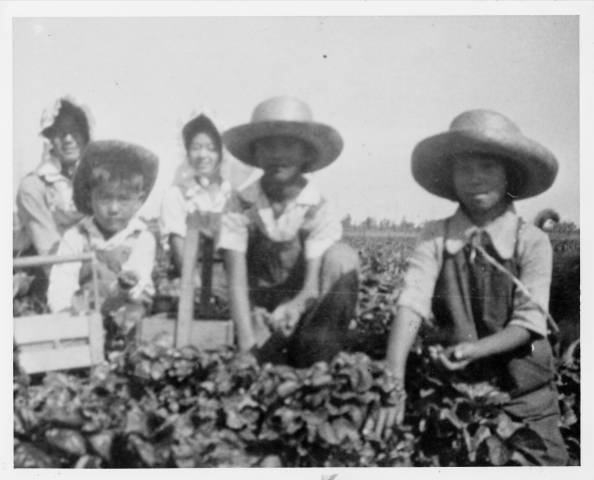
The area now called Florin was not far off the beaten path created by the discovery at Sutter’s Mill. It missed out however on the politics of statehood and would find its future because of a gifted immigrant who developed a tremendous knowledge of plants and their fruit.
As the Central Pacific’s largely Chinese work force was completing the western leg of the transcontinental railroad, the railroad’s managers were thinking about building a much shorter line— Sacramento to Stockton. As plans were being firmed up, a stop was considered near a village nine miles southeast of the Capitol.
Edwin B. Crocker, legal counsel for the railroad, is said to have named the area Florin because he saw many wildflowers when he visited. A post office was granted in 1869. The train station, duly named Florin, was completed in 1875, the same year Crocker, a former California Supreme Court justice, died from the effects of a stroke.
Some of the Chinese laborers who built the transcontinental railroad had stayed on for the short line’s construction. They may have become part of the farm labor for the region or joined those who had settled in the Central Valley after the gold petered out. Much of the work draining the Delta and establishing farms was done by Chinese immigrants until 1882. The Chinese endured discrimination going back to the 1850’s despite being a reliable work force. Then Chinese Exclusion Act passed by the U.S. Congress in 1882, banned immigration from China for ten years. Current Chinese in America could not become citizens.
Japanese Fill the Void
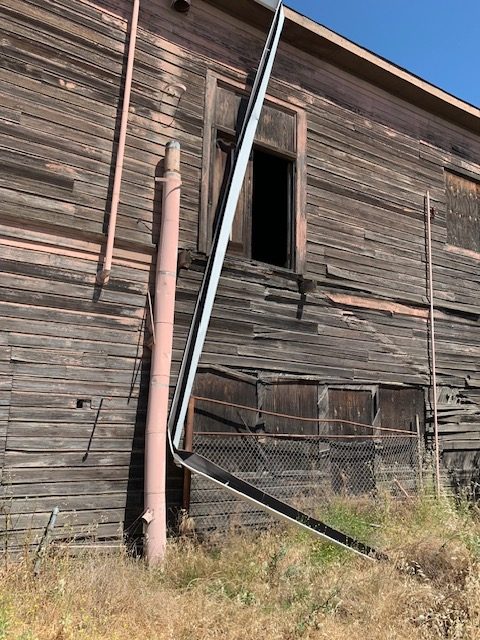
So agricultural leaders looked elsewhere in Asia for replacements. Under pressure from Europe and the United States, Japan had been opened up to modernization. Emperor Meiji took measures to adopt new technology and improve the economy. He also became open to emigration.
But the southern Islands of Japan had been left behind, and the largely agricultural areas were struggling. Poor young men, particularly if they were not the eldest son in their family, looked to America as a place they could make more in wages. Most planned to work a few years and return to Japan for marriage and a family.
The first Japanese arrived in the 1890’s in the Delta. They made less than the Chinese, not even a dollar a day. In 1896, according to government documents, four Japanese families came to Florin and started growing strawberries. More followed and by 1902, three businesses had been established to pack and ship berries. The town was growing as more acreage surrounding it was planted. The Japanese growers innovated by putting grape vines between rows of strawberries. That way they got two crops with different harvest times to spread out the work and revenue.
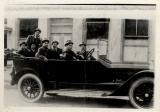
Between 1900 and 1910, the Japanese population in U.S. tripled with 41,356 in California. In 1909, the Immigration Commission estimated 450 Japanese were living in Florin, 314 adult males and the rest split between adult women and children. Three years later, the number was close to 1,000 residents of Japanese heritage.
The first-generation Japanese immigrants now comprised almost a third of the labor force in the Delta, with the Chinese making up about a quarter. Together, they outnumbered the Caucasians in the fields. To support the growing Japanese community in Florin, stores and other businesses operated by immigrants were located near the train tracks, including a basket factory, restaurants, boarding houses, pool hall, ice cream parlor, and several dry goods stores.
In 1910, two more rail transportation options were inaugurated. The Western Pacific railroad was built to the west of town, providing a second opportunity for freight and passenger service. It went to the Bay Area and via Sacramento and the Feather River valley, to the middle of the country. A train powered by electricity, the Traction line, was built and ran on the east side and went to a terminal in downtown Sacramento.
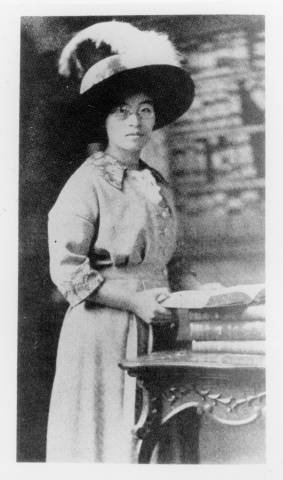
A welcome newcomer to Florin in 1910 was Matsue Maeda Suzuki, a doctor who was married to Kichisuke Suzuki, a pastor. Medical services were in demand, as it would take most of a day to get to the hospital in Sacramento’s Japantown and back. It was also the only hospital in the capitol that would treat Asians.
Sacramento’s Nihonmachi was one of the largest Japanese neighborhoods in America. It was also adjacent to the city’s main shopping streets, with dime and drug stores, as well as Montgomery Wards for other dry goods. Until cars became affordable, passenger service on trains was the fastest way to make the trip.
Anti-Asian Legislation
The nearness to the Capitol helped make Florin a target as racist vitriol transferred from the Chinese to Japanese. The newcomers outnumbered American born residents and Florin’s Japantown became the bulk of downtown. There were renewed national efforts to limit immigration from Japan, with the 1907 quasi-official Gentlemen’s Agreements between the Japanese and American governments. In return for shutting off new emigration from Japan, the U.S. agreed to recognize immigrants already here, and to allow unification of families. This resulted in a spate of arranged marriages, and a subsequent baby boom starting in the 1910’s.
It was easy to point to nearby Florin as an example of the threat that Japanese represented. Field trips were made to examine “the Japanese problem.” Anti-Japanese organizations formed, newspapers including the Sacramento Bee editorialized and the legislature held hearings. What was a thinly veiled battle for economic control resulted in California’s passing an Alien Land Act in 1913. Governor Hiram Johnson signed it, making it illegal for Korean, Japanese, Chinese and Indian immigrants to own property. They could lease land, but only for three years at a time. Other western states followed with their own legislation.
The boom in immigration in the 1910’s, including more women from the arranged marriages, provided a way around the legislation. The unions produced children who were U.S. citizens by birth. Farmers started putting deeds in the name of their kids, or another relative or friend who was a citizen. Others formed growers associations to jointly market their produce or buy equipment, seeds and fertilizer. On Florin’s main street, by 1913, only one store was owned by a Caucasian with the rest owned or operated by Japanese.
An article in the San Francisco Chronicle on January 16, 1918 reported 100 Japanese farmers in Florin owned 2,000 acres of land, with about 300 leasing a total of 3,000 acres. On owned land, the observed, farmhouses are well maintained. But on the leased land, the houses are substandard.
The article quotes a farmer on the challenges faced in the area. “This is the poorest land in Sacramento County, thin poor clay underlaid by tough hardpan.” The story went on to conclude that most of the newcomers have to work four to five years before being able to buy or lease land. Headlines in the nearly full-page coverage are titled: Japanese Farmers Have Transformed Florin into the Richest Garden, Japanese Anxious to Be Americans and Land Law Hampers Vineyard Planting.
Next Battleground—Schools
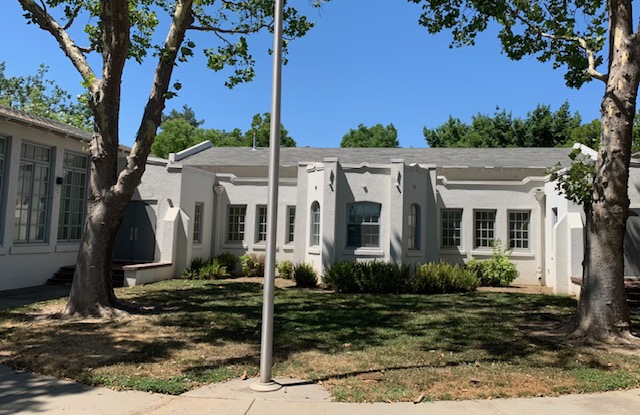
Florin School was started in 1887, built on McComber Lane east of the Central Pacific Railroad tracks. The first teacher at the one room school was Fannie Osborn. By 1901, 71 students attended the school, and a second teacher was required.
A photo from 1910 shows the students in front of the building with their teachers. About a third appear to be Japanese Americans. Overalls are popular school garb for the boys, the girls in long dresses. Many of the students had farm chores to do before and after school.
In 1914, authorities decided to segregate the students by race. A new brick school was built to the west of Florin for Caucasian children. Florin was to be one of four towns with segregated public schools in Sacramento County. The state’s School Law was changed in 1921 to allow for separate schools “for Indian children, and for children of Chinese, Japanese or Mongolian parentage.” In 1939, the leaders of the Florin Japanese Citizen League chapter, formed just a few years earlier, were finally able to bring about a change in policy. They appealed to both the Florin School Board members, and the Sacramento County Superintendent of Schools, R.E. Golway, and when the new school year started in the fall, segregation was ended.
The Florin East Grammar School building still stands on Florin Road, not far from the railroad tracks and Olde Florintown Park. The rest of the segregated schools in Sacramento County are long gone, and almost all of the descendants of the Japanese American students who attended school in Florin are living elsewhere.
Heyday For Florin’s Japantown
In 1925, one more family came to Florin, destined to make a difference. The Dakuzaku’s were drawn by the strawberries but had a profound impact on education and civic life during the height of Florin’s Japanese community. Chosei Dakuzaku and Kame Yoshinaga had been married in Okinawa in 1904 and the young groom at 17 set off for America. He established himself in San Francisco’s Nihonmachi, opening a dry cleaning business. But Kame didn’t emigrate for more than a dozen years.
Once reunited children were born, first being daughter Mary in 1917, followed by four more siblings. The family moved to Turlock in the San Joaquin Valley where they grew melons, then relocated to Florin. When the kids were old enough, one by one they started working on the farm while attending the segregated grammar school.
Mary attended high school in Elk Grove, and with the help of a teacher, received a scholarship to attend College of the Pacific in Stockton in 1933. However, she lacked additional funds to complete college, and had health issues. She dropped out short of her degree and in 1936 married Iwao “Alfred” Tsukamoto.
Tsukamoto was the son of one of Florin’s early settlers. His father Kuzo was from Hiroshima and had worked in Hawaii before going to Vancouver and then sneaking over the border to Montana. He worked his way to Colorado Springs, Fresno County and Sacramento before settling in Florin in 1892. Kuzo got a job on the Reese Ranch near Pritchard Road. In an oral history, Al Tsukamoto says his father told him there was only one other Japanese in Florin at that date.
Kuzo married Ito Kadakawa in 1910, and Iwao was born two years later. Several daughters would come along as well. Kuzo planted grape vines for Reese, who also owned a general store. The children attended the segregated grammar school, and that’s where Al met Mary.
Later, as newlyweds, the couple joined the new Japanese American Citizens League, with Mary becoming an officer of the Florin chapter. They became parents of daughter Marielle in 1937.
In the 1930’s there were two Japanese language schools that offered classes after the public school day was done. Some classes were also offered on Saturdays. There was a Methodist Church where Mary taught Sunday school, and a Buddhist one that had been built in 1919. Florin was now established as the “Strawberry Capital of the World.” The local farmers were crushing records for Tokay grape crops, shipping 130 railcars from Florin in 1941.
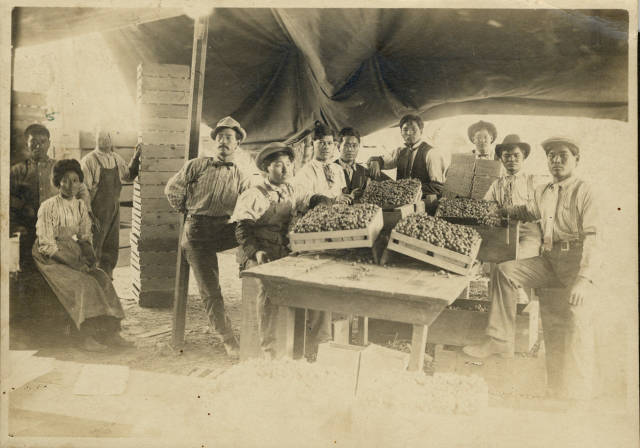
A Quiet December Sunday Morning
“When the war started, it was Sunday morning,” recalled Al Tsukamoto. “I was listening to the radio. When I heard the news, I broke into the Methodist Church service (a quarter mile away) and told them what was happening.”
Tsukamoto noted that the next day, FBI agents came and questioned officers of community groups, and language school teachers. He added that the strawberry crop was just ripening.
It was a chaotic time, with rumors circulating on what would happen, and when. Older Japanese immigrants who did not speak English well were at a disadvantage, contemplating losing everything they had worked decades to secure, a negotiating sales of possessions large and small. On the other end of the age spectrum, Japanese American college students from the Valley were forced to drop out. Some had been attending schools at coastal colleges and that area was now off limits, unless they obtained a pass from local law enforcement.
Early in 1942, Florin’s adults were ordered by the Wartime Civilian Control Authority to go to the Masonic Hall in Elk Grove and register so the government would have current information on where Japanese families were living, their ages, and other information that could be used to keep tabs on them, and plan for their removal.
In March, Al Tsukamoto attended a meeting in San Francisco for leaders of JACL chapters. The purpose was how to respond to Executive Order 9066, issued the month before to give the government the right to remove Japanese and their U.S. citizen children to the interior of the country. Since noncompliance could be met by jail or fines, the options were limited. Both Mary and Al joined other JACL representatives in discussions with government officials in charge of removal, plus those overseeing banking and farm administration. A number had their bank accounts frozen, especially if their funds were held in an American branch of a Japanese bank.
Al Tsukamoto had a friend, Bob Fletcher, who worked for a government agency inspecting fruit crops. Fletcher volunteered to mind the Tsukamoto’s fields, as well as those of two other families. They agreed that Fletcher would split the profits from the crops, and also pay local property taxes and farm mortgages. Fletcher later said “It was the right thing to do.” He made arrangements to leave his government job and become a caretaker farmer.
What became a farewell edition of the Florin JACL chapter was mimeographed on May 23, 1942. It opened with chapter officer Mary Tsukamoto’s essay, which included this observation:
“Practically all the vineyards are ready with ditches plowed for irrigation. And it is sad that we must leave, but we have no other choice. The years of living with our farmers have rooted our very souls deep into the earth of Florin. Whoever we go, whatever our faith, nothing can take away our love for Florin.”
Dividing for Assembly
The newsletter went out the same day fliers were nailed to posts and walls throughout Sacramento and Amador counties. Executive Order 92 directed Japanese and Japanese American residents to report within seven days to assembly places where they would be held while more permanent concentration campus could be built in the interior of the U.S.
Florin was carved up into quarters, with the north-south railroad tracks one axis, and Highway 16 the other. Instead of all the town’s Japanese community members going to one place, they went to four. The Florin folk would always be among the smaller groups in an assembly center, and then concentration camp. They would also be at a disadvantage to the city people, who at times communicated their disdain for country folks. Division at assembly separated them from friends, and ultimately made the isolation of camp life sting even more. This was particularly felt by young people who didn’t have the fashion or swagger of teens from Los Angeles or even Sacramento.
Dislocation was already happening during the time between December and May of 1942 as some Japanese families tried to avoid incarceration by moving away from the West Coast. A few families came to Florin to get out of coastal Zone 1 which including the Bay Area. Others went further inland to Utah and beyond.
The bulk of Florin’s population would be transported by bus to a handful of assembly centers and then towards the end of summer to a half dozen facilities, which the government called relocation centers and those who were incarcerated most often referred to as camps.
Some would be released temporarily as early as fall of 1942 to work on harvests. Others got out to pursue educations or work in defense related jobs, which in some cases including laboring on farms. Men of military service age could later volunteer to fight in Europe or use their language skills at listening posts or to interrogate prisoners as U.S. forces moved island by island toward a planned invasion of Japan.
Al Tsukamoto was released from the Jerome, Arkansas concentration camp in late 1943. He had been in charge of recreational activities for adults. He first went to Chicago and then to Kalamazoo, Michigan, where he started working in a bakery. Mary and their daughter joined him in October, 1944, and then his in-laws the Dakuzaku’s came with two of their other adult children. Al worked the night shift so it wouldn’t be known the bakery employed Japanese.
Returning Home, For Some
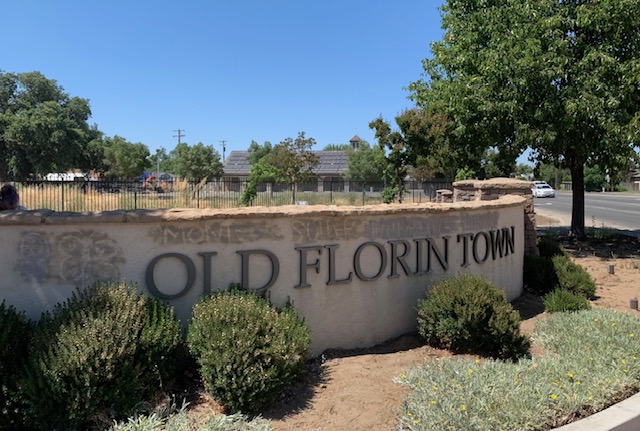
On July 21, 1944, part of Florin’s downtown was destroyed by fire, including seven residences and two commercial buildings, one of which housed the possessions of former Japanese residents. The burned area was between Tokay Avenue and the railroad tracks, on the north side of Florin Road. At the time, the federal government was beginning to consider closure of the concentration camps but it is unclear if the fire was deliberately started to discourage return.
The first to come back to Florin was Masao “Mike” Umeda, on January 6, 1945. He had placed his land under stewardship of the Florin Fruit Growers Association. FGA leaders in turn leased the land to a Caucasian farmer, who maintained it in good order. Umeda had put most of his family’s possessions in a government storage place and was able to retrieve it. A neighbor had ably taken care of his car.
There was palpable opposition in the Central Valley to Japanese coming back. Local government councils and boards passed resolutions in opposition. Newspapers editorialized as well. Some resort to terrorism. Not long after the first handful returned to Florin, there were two suspicious fires. One was close to the Umeda’s place, a 2 a.m. torching of a home. The Mukai family, which owned the house, was still incarcerated. A second arson in Florin followed. It wasn’t an isolated experience. Newspapers reported an attempted firebombing in Placer County, and night riders shooting into homes of several Japanese families in Merced County shortly after their owners came back.
Marielle Tsukamoto related her family’s trip home in 1946, saying her father borrowed his brother’s car and drove across the country, taking a southern route. They stopped at the Gila reservation facility to visit relatives, then crossed into California. Al Tsukamoto waited until evening to drive into Florin and when they approached their home, he turned off the headlights and didn’t turn on the house lights once inside.
But the Tsukamoto’s started over and soon welcomed other returnees. “I remember three or four families with us until they were settled,” recalled Marielle. “My Dad would have them help on the farm, and we would pool all of our resources and take turns cooking. We would sleep on the floor with a blanket. The children slept in the hallway. I think there must have been 14 or 15 people in a tiny two-bedroom house.”
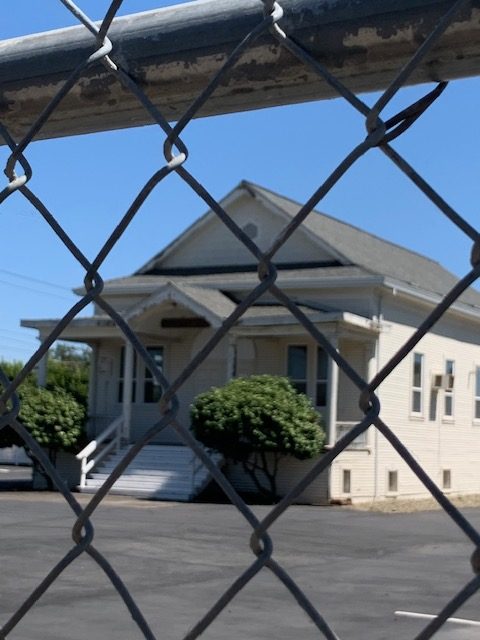
The Methodist Church and Buddhist Church buildings became dormitories, with spaces cordoned off as ropes with blankets hung over them gave a bit of privacy. Some lived in those church halls for two years. Others eventually found other places to live in towns or cities, leaving Florin behind.
The scattering of Florin’s vibrant pre-war community was so significant that only a fraction returned. Some were still saving their country. Those in the Military Intelligence Service had been preparing for an invasion of Japan. When the surrender made that unnecessary, there was still occupation work ahead, as the U.S. under Douglas MacArthur ran the country into the 1950’s. People who had left California in 1942 to avoid incarceration often decided to stay away from the west coast. Young people resumed to school or started their education under the G.I. Bill if they’d served in the military. With a degree or certificate in hand, better jobs were in big cities, not a country town like Florin and certainly not the hard life of a farmer.
Less Than 10%
There is no exact number for how many returned to Florin. But Mike Umeda said in a 1993 oral history interview “It was not even 10%. They had nothing to return to.” He went on to explain that many of the Japanese who had made personal agreements to operate farms lost everything because property taxes weren’t paid. Or they had sold their land in the spring of 1942 for whatever they could get and were no longer tied to agriculture.
Lily and Mike Umeda persevered after the war. They had married in 1933 and had two farms two miles apart. Lily recalled in an oral history from 1993 that she walked as a newlywed between the two to work in the fields, while also doing the bulk of housework. Her in-laws lived with them. Mike had put their farm goods and personal effects in a government storage facility and leased the farms to the Florin Growers Association. Everything was there when they got back. Looking back four decades after resuming farming, Lily summed up life in Florin, saying “We weren’t rich, we were always on the poor side. But in the end, we got this house to live in, and the children all come back to us. I’m grateful.”
Lester Ouchida was just a boy when his family was incarcerated. A neighbor, Mary McComber, took care of their house, renting it to a minister and sending the rent on to Lester’s parents. He grew up in not one, but two camps. His father Yasuji had owned a fruit distribution company before the war. Once home, it reopened but Lester said it wasn’t a successful operation as when it had 10 trucks taking produce from farms to markets in the 1930’s.
That decline in fortune could be said for Florin’s agriculture in general. Tokay grapes, which had seeds, lost favor with consumers for ones that were seedless. And there was new competition from grapes grown in other parts of the Central Valley and other countries. Vineyards in the area were starting to turn toward other varietals, especially Zinfandel, looking to make wine instead of grapes for eating. For the Tsukamoto’s, Al quit farming in 1947 and went to work in a civilian job at the Army Depot just a handful of miles away. Mary became a teacher as Marielle completed school.
Mary Tsukamoto taught for 26 years in Florin and Elk Grove. But she went far beyond the classroom as an educator. She started a Time of Remembrance program to bring together students and those who had been incarcerated and wrote a teaching guide. She authored We the People: A Story of Internment in America, and collaborated with the Smithsonian Institution on a Bicentennial exhibit about forced removal of Japanese and Japanese Americans. Mary Tsukamoto inspired others to share in the work of documentation, helping Sacramento State librarians to establish the priceless Japanese American Archival Collection, which has items from 200 individuals, including her own photographs and documents.
Becoming A Suburb
The military, including two airfields, had driven growth in the Sacramento region during the war. In addition to civilians in the war effort, veterans who had enjoyed the climate decided to start their post-war lives in the area. President Eisenhower’s vision for a new interstate highway system resulted in widening Highway 99 and realigning Highway 50 as it went past the exit to the Florin area. The baby boom drove demand for suburban housing, and Florin got swallowed up in the 60’s and 70’s as farmland increasingly grew houses instead of fruit. As one historian put it, “Florin became less of a town and more of a community or neighborhood.”
Florin continued to grow as an unincorporated community after the start of the new century. In 2010, Sacramento County staff presented a vision for the future of the Japantown streets, proposing an Old Florin Town Planning Area. The hope was to create additional housing opportunities, establish a theme for the area, and preserve the historic village center.

In doing the planning, experts established historic district boundaries and rated buildings in it for relevance to the past. They designated more than a dozen structures in the 8200 and 8300 blocks of Florin Road as contributing to the historic district, along with one on Tokay Avenue. Planners also proposed constructing a monument at the corner of McComber Street and Florin Road.
An Environmental Impact Report was approved in 2011, including the monument, a low curved wall with lettering spelling “Old Florin Town.” Many elements of the plan had merit, but not the uplifting impact officials anticipated over time. Today, a few buildings in the district are well maintained, notably the Buddhist Church at Florin and Pritchard Roads. It’s actually two churches—the older one is on a historic registry and protected by a chain link fence and behind it the newer one, which will host the Obon Festival.
Florin is one of the most blighted parts of Sacramento County, with many vacant lots where farms growing strawberries and grape vines once flourished. A number of buildings in the historic district are empty and deteriorating. On a recent visit, behind the monument wall was a small homeless camp.
AsAmNews is published by the non-profit, Asian American Media Inc.
We are currently funded by our readers and such charitable foundations as the Robert Wood Johnson Foundation, AARP, Report for America/GroundTruth Project & Koo and Patricia Yuen of the Yuen Foundation.’
Find additional content on Bluesky, Facebook, Instagram , Tiktok, X, and YouTube. Please consider interning, joining our staff, or submitting a story, or making a tax-deductible donation.
You can make your tax-deductible donations here via credit card, debit card, Apple Pay, Google Pay, PayPal and Venmo. Stock donations and donations via DAFs are also welcomed. Contact us at info @ asamnews dot com for more info.


